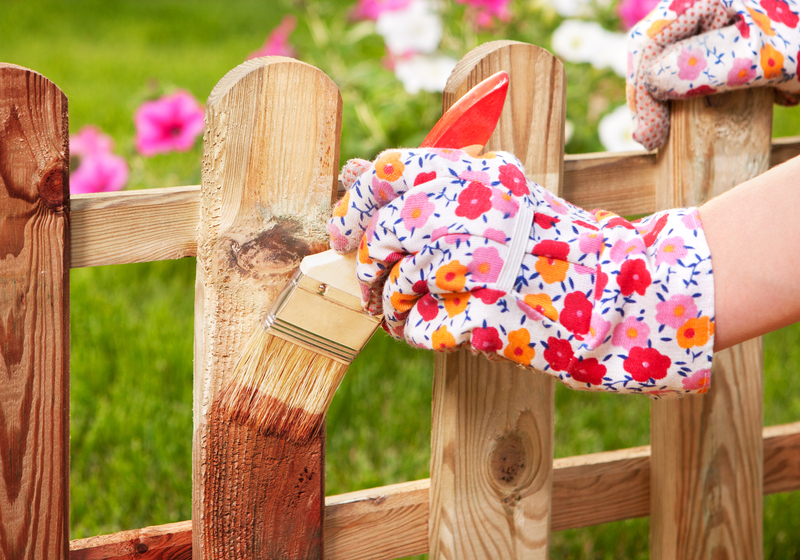How to Plan a Garden that Thrills and Excites Children
Posted on 20/09/2025
How to Plan a Garden that Thrills and Excites Children
Creating a garden that captivates the imagination of children is a rewarding experience for families, schools, and communities. Not only does such a garden foster a love for nature and the outdoors, but it also provides unique learning opportunities, encouragement of creativity, and joyful play. In this comprehensive guide, you'll discover how to plan a garden that thrills and excites children, ensuring the space becomes a cherished destination for adventure and curiosity.

Why Create a Child-Friendly Garden?
Gardens designed with little ones in mind offer countless benefits beyond just aesthetics. Let's explore why planning a children's garden is important:
- Encourages Physical Activity: Interactive spaces prompt running, jumping, and exploring.
- Stimulates the Senses: A blend of vibrant colors, interesting textures, and wonderful scents enrich the sensory experience.
- Promotes Learning: Watching plants grow teaches patience, biology, and responsibility.
- Sparks Creativity: Themed zones, natural materials, and whimsical structures foster imaginative play.
- Develops Connection with Nature: Children grow up respecting and valuing the world around them.
How to Begin: Planning a Children's Exciting Garden
Before picking up a shovel, strategize your garden's layout and features. Preparation is the key to building a space that's safe, fun, and engaging.
1. Consider Your Space and Environment
- Assess the Area: Note the sun's path, shade, existing structures, and size.
- Identify Hazards: Remove toxic plants, sharp objects, unstable walls, and unsafe surfaces.
- Pick Accessible Locations: Ensure pathways and plant beds are easy for children to reach and navigate.
2. Involve the Children from the Start
Make the garden planning process thrilling by inviting children's input! Ask about their favorite colors, animals, scents, or fairy-tale themes. When kids feel ownership of their space, their excitement and engagement soar.
3. Divide the Garden into Themed Zones
- Sensory Zone: Filled with touchable plants, aromatic herbs, wind chimes, and textured stepping stones.
- Edible Garden: Raised beds or pots packed with strawberries, cherry tomatoes, peas, and other kid-friendly crops.
- Wildlife Corner: Native flowers, bird feeders, insect hotels, and shallow water features to attract pollinators.
- Pretend Play Area: Spaces with logs, willow tunnels, or fairy gardens for creative storytelling and adventures.
- Art and Craft Zone: Outdoor tables for painting rocks, making plant labels, or constructing bug hotels.
Choosing Plants for a Magical and Exciting Children's Garden
The right flora electrifies your garden, inviting hands-on exploration. Here's how to select plants that thrill and excite kids:
1. Vibrant Colors and Interesting Textures
- Bright annuals: Sunflowers, marigolds, nasturtiums, and zinnias offer visual impact and quick results.
- Soft and fuzzy: Lamb's ear (Stachys byzantina) and mullein have leaves kids love to touch.
- Spiky surprises: Grasses like blue fescue or bottlebrush.
2. Whimsical and Fast-Growing Plants
- Giant sunflowers: Challenge kids to plant and measure them as they race skyward!
- Sweet peas and morning glories: Twine for teepeeing or to create secret hideouts.
- Pumpkins and squashes: Watch as tiny green buds become magical Jack-o-lanterns by autumn.
3. Edible Delights for Tiny Taste Testers
- Berry bushes: Blueberries, raspberries, or strawberries entice kids to harvest their own snacks.
- Cherry tomatoes and sugar snap peas: Perfect for nibbling straight off the plant!
- Herbs: Mint, basil, and lemon balm offer unmistakable scents and flavor.
4. Sensory Stimulators
- Touch: Soft mosses, feathery ferns, bumpy gourds.
- Scent: Lavender, chocolate cosmos, curry plant, and scented geraniums.
- Sound: Bamboo for rustling breezes, ornamental grasses, wind chimes, and seed pods.
Design Ideas and Features that Excite Children in a Garden
A thrilling children's garden is more than plants—it's about experiences. Here are the best features to delight kids of all ages:
1. Secret Spaces and Hideaways
- Willow domes or living tunnels spark a sense of adventure and privacy.
- Sunflower houses: Plant sunflowers and climbers to make natural play forts.
- Cubbyholes behind tall plants or with a small tent hidden in a shaded corner.
2. Paths and Maze Gardens
- Curvy, winding paths invite exploration, lined with stepping stones or groundcovers.
- Mini hedge mazes or labyrinths using lavender, boxwood, or even tall grasses.
3. Water Play and Mud Kitchens
- A shallow basin, bubbling fountain, or simple puddle area for safe, supervised water play.
- Mud kitchens complete with old pots, pans, and utensils for stirring up imaginary feasts.
4. Wildlife Wonders
- Butterfly and bee attractors: Milkweed, coneflower, borage, and cosmos.
- Mini ponds: Home to frogs and WATER-loving insects.
- Birdhouses, feeders, and bug hotels for observing creatures up close.
Incorporating Playful Structures
Install or build simple garden structures to take the joy even further:
- Swings or hammocks (safely anchored, soft surfaces below).
- Climbing frames or logs to balance on.
- Small bridges, archways, or painted stepping stones to adventure across.
- Teepees or tents for secret meetings or fairy tale storytelling.
Gardening Activities to Keep Children Engaged
A joyful children's garden isn't just about how it looks; it's about what you do there. Regularly involve kids with playful gardening activities:
1. Make Planting Exciting
- Seed Bombs: Mix seeds and compost into balls for tossing and watching wildflowers grow.
- Grow Experiments: Start beans in clear jars with cotton wool to watch roots unfurl.
- Design Mini Gardens: Let each child plan and tend their own pot or small patch.
2. Hands-On Maintenance
- Kid-sized tools for safe digging, raking, or watering.
- Sorting and composting garden scraps, learning about worms and recycling.
3. Seasonal Fun
- Spring bulb planting, summer flower pressing, autumn leaf crafts, and winterbird feeding.
Create Art and Memories
Encourage artistic expression and make long-lasting memories with these garden crafts:
- Pebble painting for path markers or decorations.
- Nature collages with leaves, petals, and twigs.
- Build scarecrows or decorate pots with bright paints.
- Photograph plant growth and wildlife to create a garden journal.
Safety First: Ensuring a Secure Exciting Garden for Kids
- Use organic, non-toxic gardening methods.
- Choose plants that are non-poisonous and safe to touch or taste.
- Ensure tools, fencing, and structures are sturdy and age-appropriate.
- Install gates or barriers to keep little ones away from roads or ponds as needed.
- Supervise new activities and teach garden safety rules.
Maximizing Learning: Educational Touches for Children's Gardens
Make your magical garden a living classroom as well as a playground:
- Science explorations: Examine bug life, weather, soil, and the plant life cycle.
- Math and measuring: Chart plant growth, count petals, pattern stepping stones.
- Storytelling: Use fairy gardens, puppet theaters, or outdoor bookshelves.
- Responsibility: Assign regular watering or weeding tasks to foster ownership and pride.
Maintenance Tips for a Thrilling Children's Garden
- Keep paths clear and non-slip for running feet.
- Trim back vigorous climbers or thorns to prevent accidents.
- Quickly remove weeds or unwanted growth, inviting children to help spot "garden invaders."
- Refresh mulch, compost, and add new features each season so the garden always feels new and exciting!

Frequently Asked Questions About Planning a Children's Garden
What is the best age to introduce children to gardening?
Any age is a great age! Start toddlers with sensory play and harvesting, progress to more involved activities as they grow. There's always a perfect job for every developmental stage.
Which plants are safest for small children?
Sunflowers, nasturtiums, marigolds, snapdragons, peas, beans, and most culinary herbs are safe and easy for little hands. Avoid plants with toxic berries or sap.
How do I keep children excited about gardening all year?
Include seasonal crafts, wildlife watching, and continually evolving features (like ever-changing fairy gardens, delicious crops, or winter feeders). Consistent involvement keeps the magic alive.
Conclusion: Create a Garden that Sparks Joy and Curiosity
Designing a garden that thrills and excites children means blending imagination with nature. By incorporating vibrant plants, magical spaces, and playful features, you create a living playground that's endlessly inspiring for both youngsters and adults. Involve children at every step, encourage exploration, and enjoy the proud smiles and laughter that come from your own backyard adventure. A well-planned kids' garden isn't just a patch of earth—it's a world of wonder, learning, and lifelong happy memories.



